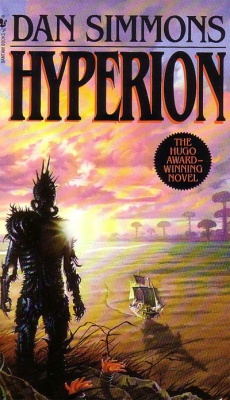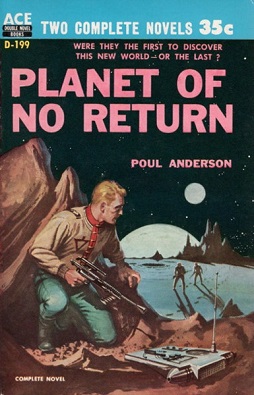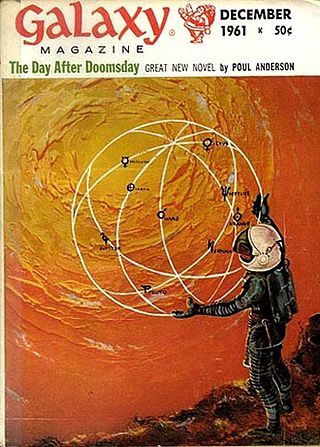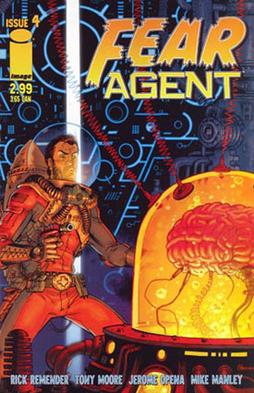Plot summary
Humanity has met four other intelligent non-human races. While the other four races share many similarities, humans are unique among the five races in many ways.
Harg Tholan, a medical researcher from Hawkin's Planet, visits Earth to work at the Jenkins Institute for the Natural Sciences. Research biologist Rose Smollett offers to host him in her home. Her new husband Drake, a member of the World Security Board, dislikes Tholan's presence.
During dinner conversation, Tholan explains that he is investigating "Inhibition Death". The alien lists several unique things about humans: they are the only sentient race to eat meat, they lack any sort of telepathic ability, and to the Smolletts' great surprise, they are the only race to routinely die of old age. Tholan reveals that the other races normally live indefinitely, growing at an ever-slowing rate over time, like Earth trees. Inhibition Death stops the growth, leading to death in a human-like way. He says that the disease has become much more common since travel between Earth and other planets began, and planets closest to Earth suffer the highest rates.
Tholan asks Drake if he can be given a tour of a Missing Person's Bureau. The alien is intrigued by the idea, as the telepathy between members of other races makes missing people impossible. Drake agrees to take him to a police station the next day.
That night, Drake tells Rose that Tholan had asked about him before the visit, and implies that he is there to see him, not Rose. The next day, Rose reads some of Tholan's work which causes her to abandon the notion that he is an imposter. She considers whether the disease was created on Earth as a biological weapon, but rejects it as impossible, given humans' lack of understanding of alien physiology. Thinking of her recent marriage, she wonders if Drake married her to meet Tholan, but rejects this as the timing was not possible. Reviewing the dinner conversation, she remembers Drake's seemingly overreaction to Tholan's polite mention of what a good hostess she was.
At home, Rose mentions her research to Drake. He asks if Tholan has published any conclusions on how the disease spreads; he has not. Drake immediately confronts Tholan with a weapon. Tholan admits that he has come to a conclusion about the cause of the disease, but his research methods are repugnant to other Hawkinsites, so he had to keep it secret. He explains that the disease has been on Earth for millions of years, and higher animals live with it within their DNA [a] as a sort of parasite. Humans are now partially immune to its effects, but eventually succumb. To spread, the disease controls human behavior, urging males—especially those in the first year of marriage—to have wanderlust so they can infect new hosts. Tholan notes that with the development of interstellar travel, almost all missing persons have fled to space.
After Tholan admits that he has told no one else of the theory, Drake kills him. He says he did this to avoid interstellar war, as the other races would attack Earth to destroy the parasites. Rose realizes that he and the Security Board had to have been aware of Tholan's theory already. She notes Drake's reaction to Tholan's use of the term "hostess" and her offhand mention of mosquitos, carriers of disease. Drake admits that they are indeed aware of the disease, but can do nothing; it now lives in a symbiotic relationship with humans, its growth-inhibiting properties preventing cancer from killing everyone. Drake leaves with the body.
As she waits for him to return, Rose realizes Drake is lying. The disease cannot inhibit cancer, because children get cancer while still growing, before the disease has expressed itself. She realizes the real action of the disease: There are two forms and they need to mix genes before producing a form that spreads to aliens. This is why Drake married her; they carried the two different forms and the disease was mating. Rose realizes that her husband will never return.

Frank Donald Drake was an American astrophysicist and astrobiologist.
"The Screwfly Solution" is a 1977 science fiction short story by Raccoona Sheldon, a pen name for American psychologist Alice Sheldon, who was better known by her other nom de plume James Tiptree Jr. When the story was first published in June 1977, the identity of Alice Sheldon as both Tiptree and "Raccoona" Sheldon was unknown to the public or anyone in the science fiction community; a series of events triggered by the death of Sheldon's mother Mary Hastings Bradley in October 1977 resulted in the identity behind the pen-names being revealed by the end of the same year.

Interstellar Pig, published in 1984 by Bantam Books, is a science fiction novel for young adults written by William Sleator. It was listed as an ALA Notable Book, a SLJ Best Book of the Year, and a Junior Literary Guild Selection.

Hyperion is a 1989 science fiction novel by American author Dan Simmons. The first book of his Hyperion Cantos series, it won the Hugo Award for best novel. The plot of the novel features multiple time-lines and is told from the point of view of many characters. It follows a similar structure to The Canterbury Tales by Geoffrey Chaucer. A framing narrative serves as a means to present the tales of a group of pilgrims sent to Hyperion's time tombs, to make a request of the Shrike, a metallic creature that is said to grant one wish to each pilgrim. The story is continued in The Fall of Hyperion, published in 1990.
My Teacher Is an Alien is a four-book science fiction children's book series authored by Bruce Coville. The titles include:

Babylon 5: A Call to Arms is a 1999 American made-for-television film and the fourth film set in the Babylon 5 universe. It was written by J. Michael Straczynski, directed by Mike Vejar, and originally aired on TNT on January 3, 1999, as one of two films shown over the 1998–1999 season to fill in the gap between the fifth season of Babylon 5 and the spin-off series Crusade.
"New Earth" is the first episode of the second series of the British science fiction television series Doctor Who. It was first broadcast on BBC One on 15 April 2006.

Question and Answer is a science fiction novel by American writer Poul Anderson. It originally appeared in the June and July 1954 issues of magazine Astounding Science Fiction, and was later reprinted in 1956 as part of Ace Double D-199 under the title Planet of No Return, and again as a stand-alone Ace novel in February 1978 under the original title.

After Doomsday is a science fiction novel by American writer Poul Anderson. It was published as a complete novel in 1962, having been serialized as The Day after Doomsday in the magazine Galaxy, between December 1961 and February 1962.

Line of Delirium and Emperors of Illusions are two 1995 books of a space opera trilogy by Russian science fiction writer Sergey Lukyanenko. The story is told in third person, usually from the viewpoint of Kay Dutch — a professional bodyguard living in a post-war galaxy. The names of races, planets, and several leaders are borrowed from the computer game Master of Orion, although everything else in the trilogy is original, even the physical descriptions of several races.

Fear Agent is an American science fiction comic book series written by Rick Remender with art by Tony Moore and Jerome Opena, who alternated on story arcs. The series was published by Dark Horse Comics from 2007 to 2018 and by Image Comics from 2005–2006 and currently from 2018.

Peeps is a 2005 novel by Scott Westerfeld revolving around a parasite which causes people to become cannibalistic and repelled by that which they once loved. It follows the protagonist, Cal Thompson, as he lives with this parasite and tries to uncover a possible threat to the whole population of the world. The apocalyptic threat to the world that begins in Peeps continues in The Last Days, which features some of the same characters.

Radiant is a science fiction novel by the Canadian author James Alan Gardner. It was published in 2004 by HarperCollins Publishers under their Eos Books imprint. It is the seventh novel in Gardner's "League of Peoples" series. Like the six preceding novels, Radiant is set in the middle of the 25th century; like most of them, it takes place in outer space and on alien planets, and features the continuing character Festina Ramos.

"The Inspector's Teeth" is a science fiction short story by American writer L. Sprague de Camp, part of his Viagens Interplanetarias series. It is the first (chronologically) set on Earth, and a linchpin tale in the sequence, showing how the interstellar political system forming the background of the rest of the series was established. It was first published in the magazine Astounding in the issue for April, 1950. It first appeared in book form in the collection The Continent Makers and Other Tales of the Viagens, published in hardcover by Twayne Publishers in 1953, and in paperback by Signet Books in 1971. It also appeared in The Best of L. Sprague de Camp, and Anthropomorphic Aliens: An Interstellar Anthology. The story has been translated into Portuguese, Dutch, Italian and German.

"The Colorful Character" is a science fiction short story by American writer L. Sprague de Camp, part of his Viagens Interplanetarias series. It was first published in the magazine Thrilling Wonder Stories in the issue for December, 1949. It first appeared in book form in the collection Sprague de Camp's New Anthology of Science Fiction, published simultaneously in hardcover by Hamilton and in paperback by Panther Books in 1953.

The Long Result is a 1965 science fiction novel by British writer John Brunner.

Death's End is a science fiction novel by the Chinese writer Liu Cixin. It is the third novel in the trilogy titled Remembrance of Earth's Past, following the Hugo Award-winning novel The Three-Body Problem and its sequel, The Dark Forest. The original Chinese version was published in 2010. Ken Liu translated the English edition in 2016. It was a finalist for the 2017 Hugo Award for Best Novel and winner of the 2017 Locus Award for Best Science Fiction Novel.
"Vaster than Empires and More Slow" is a science fiction story by American author Ursula K. Le Guin, first published in the collection New Dimensions 1, edited by Robert Silverberg. It is set in the fictional Hainish universe, where Earth is a member of an interstellar "League of Worlds". The anthology was released in United States in 1971, by Doubleday Books.

The following outline is provided as an overview of and topical guide to extraterrestrial life:















